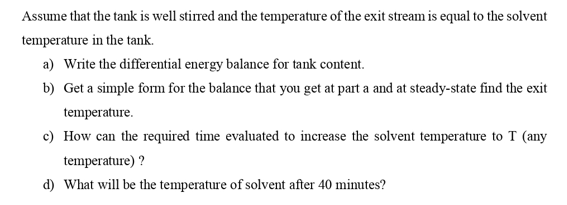3. A steam coil is immersed in a stirred heating tank. Saturated steam at 7.50 bar inlets the coil and after it condensed it exits the coil at same temperature. A solvent which has 2.30 kJ/kg heat capacity is fed to tank at 25 °C with 12 kg/min constant flow rate and it exits the tank with same flowrate. Initially the tank is at 25 °C temperature and includes 760 kg solvent. At t=0 both the heating steam and solvent are feed to the tank. Heat transfer from steam to the solvent is given by the equation Q(kJ/min) = UA(Tsteam-T) Here UA is the product of total heat transfer coefficient and transfer surface and it is equal to 11,5 kj/min °C. Assume that the tank is well stirred and the temperature of the exit stream is equal to the solvent temperature in the tank. a) Write the differential energy balance for tank content. b) Get a simple form for the balance that you get at part a and at steady-state find the exit temperature. c) How can the required time evaluated to increase the solvent temperature to T (any temperature) ?
3. A steam coil is immersed in a stirred heating tank. Saturated steam at 7.50 bar inlets the coil
and after it condensed it exits the coil at same temperature. A solvent which has 2.30 kJ/kg heat
capacity is fed to tank at 25 °C with 12 kg/min constant flow rate and it exits the tank with
same flowrate. Initially the tank is at 25 °C temperature and includes 760 kg solvent. At t=0
both the heating steam and solvent are feed to the tank. Heat transfer from steam to the solvent
is given by the equation Q(kJ/min) = UA(Tsteam-T) Here UA is the product of total heat
transfer coefficient and transfer surface and it is equal to 11,5 kj/min °C.
Assume that the tank is well stirred and the temperature of the exit stream is equal to the solvent
temperature in the tank.
a) Write the differential energy balance for tank content.
b) Get a simple form for the balance that you get at part a and at steady-state find the exit
temperature.
c) How can the required time evaluated to increase the solvent temperature to T (any
temperature) ?
d) What will be the temperature of solvent after 40 minutes?


Step by step
Solved in 4 steps









